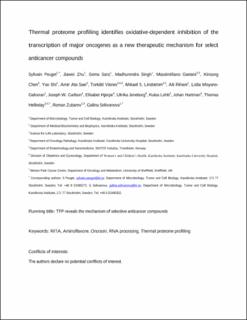Thermal proteome profiling identifies oxidative-dependent inhibition of the transcription of major oncogenes as a new therapeutic mechanism for select anticancer compounds
| dc.contributor.author | Peuget, Sylvain | |
| dc.contributor.author | Zhu, J | |
| dc.contributor.author | Sanz, Gema | |
| dc.contributor.author | Singh, Madhurendra | |
| dc.contributor.author | Gaetani, Massimiliano | |
| dc.contributor.author | Chen, Xinsong | |
| dc.contributor.author | Shi, Yao | |
| dc.contributor.author | Saei, Amir Ata | |
| dc.contributor.author | Visnes, Torkild | |
| dc.contributor.author | Lindström, Mikael | |
| dc.contributor.author | Rihani, A | |
| dc.contributor.author | Moyano-Galceran, Lidia | |
| dc.contributor.author | Carlson, Joseph W. | |
| dc.contributor.author | Hjerpe, Elisabeth | |
| dc.contributor.author | Joneborg, Ulrika | |
| dc.contributor.author | Lehti, Kaisa | |
| dc.contributor.author | Hartman, Johan | |
| dc.contributor.author | Helleday, Thomas | |
| dc.contributor.author | Zubarev, Roman A. | |
| dc.contributor.author | Selivanova, Galina | |
| dc.date.accessioned | 2021-08-19T08:23:01Z | |
| dc.date.available | 2021-08-19T08:23:01Z | |
| dc.date.created | 2020-02-06T19:34:57Z | |
| dc.date.issued | 2020 | |
| dc.identifier.issn | 0008-5472 | |
| dc.identifier.uri | https://hdl.handle.net/11250/2770217 | |
| dc.description.abstract | Identification of the molecular mechanism of action (MoA) of bioactive compounds is a crucial step for drug development but remains a challenging task despite recent advances in technology. In this study, we applied multidimensional proteomics, sensitivity correlation analysis, and transcriptomics to identify a common MoA for the anticancer compounds RITA, aminoflavone (AF), and oncrasin-1 (Onc-1). Global thermal proteome profiling revealed that the three compounds target mRNA processing and transcription, thereby attacking a cancer vulnerability, transcriptional addiction. This led to the preferential loss of expression of oncogenes involved in PDGF, EGFR, VEGF, insulin/IGF/MAPKK, FGF, Hedgehog, TGFβ, and PI3K signaling pathways. Increased reactive oxygen species level in cancer cells was a prerequisite for targeting the mRNA transcription machinery, thus conferring cancer selectivity to these compounds. Furthermore, DNA repair factors involved in homologous recombination were among the most prominently repressed proteins. In cancer patient samples, RITA, AF, and Onc-1 sensitized to poly(ADP-ribose) polymerase inhibitors both in vitro and ex vivo. These findings might pave a way for new synthetic lethal combination therapies. | en_US |
| dc.language.iso | eng | en_US |
| dc.publisher | AACR Publications | en_US |
| dc.title | Thermal proteome profiling identifies oxidative-dependent inhibition of the transcription of major oncogenes as a new therapeutic mechanism for select anticancer compounds | en_US |
| dc.type | Peer reviewed | en_US |
| dc.type | Journal article | en_US |
| dc.description.version | acceptedVersion | en_US |
| dc.rights.holder | © 2020 American Association for Cancer Research. | en_US |
| dc.source.pagenumber | 14 | en_US |
| dc.source.volume | 80 | en_US |
| dc.source.journal | Cancer Research | en_US |
| dc.source.issue | 7 | en_US |
| dc.identifier.doi | 10.1158/0008-5472.CAN-19-2069 | |
| dc.identifier.cristin | 1791795 | |
| cristin.ispublished | true | |
| cristin.fulltext | postprint | |
| cristin.qualitycode | 2 |
Files in this item
This item appears in the following Collection(s)
-
Publikasjoner fra CRIStin - SINTEF AS [5801]
-
SINTEF Industri [1566]
